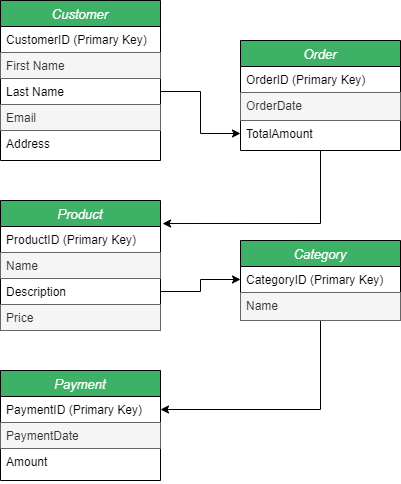Introduction to Entity Relationship Diagrams (ERD)
Entity Relationship Diagrams (ERD) are powerful tools used in database design. They visually represent the relationships between entities in a database, helping to organise and structure data effectively. ERDs are essential for understanding the logical structure of databases and are widely used by database developers, analysts, and administrators.

Why are ERDs important in database design?
ERDs play a crucial role in database design as they help understand the relationships between entities. By visualising these relationships, ERDs enable database designers to create efficient and effective database structures. They serve as a roadmap for database developers, allowing them to recognise and address potential issues before the actual implementation of the database. ERDs also serve as a communication tool, facilitating stakeholder discussions and ensuring everyone understands the database design clearly.
Key components of an ERD
To fully understand ERDs, it’s essential to grasp the key components of these diagrams. The main components of an ERD are entities, attributes, and relationships. Entities represent the objects or concepts that are stored in a database. They can be anything from a customer or an employee to a product or an order. Attributes are the traits or qualities associated with these entities. For example, a customer entity may have name, address, and email attributes. Relationships depict the connections and associations between entities. They define how entities interact with each other and establish the rules that govern their relationships.
Types of relationships in databases
In database design, it is essential to comprehend the various types of relationships among entities. The three primary relationship types are one-to-one, one-to-many, and many-to-many. A one-to-one relationship occurs when each instance of a particular entity is linked to only one example of another entity. For instance, in a university database, each student may have only one unique student ID.
Conversely, a one-to-many relationship occurs when a solitary instance of an entity is connected with multiple instances of another entity. For example, in an e-commerce website database, a single customer may have multiple orders.
A many-to-many relationship occurs when multiple instances of one entity are associated with various instances of another entity. In the e-commerce example, numerous customers can have multiple orders.
Creating an ERD: Step-by-step guide
Creating an ERD involves several steps to ensure the accuracy and effectiveness of the database design. Here is a step-by-step guide to help you through the process.
Identify the entities: Identify the main entities included in the database. These entities should represent the key objects or concepts the database stores and manages.
Identify the attributes: Identify the characteristics or properties that must be stored for each entity. These attributes will provide additional information about the entities and help define their characteristics.
Define relationships: Analyse the relationships between the identified entities. Define the relationship type (one-to-one, one-to-many, or many-to-many) and establish the rules that govern these relationships.
Draw the ERD: Using a diagramming tool or software, create the ERD by visually representing the entities, attributes, and relationships. Use appropriate symbols and notations to ensure clarity and consistency.
Validate the ERD: Review the ERD to ensure its accuracy and completeness. Check for any inconsistencies or errors in the design and make necessary adjustments.
Implement the database: Once the ERD is validated, implement the database based on the design. This involves creating the necessary tables, defining the relationships, and setting up the attributes and constraints.
Tools for creating ERDs
There are several tools available that can aid in creating ERDs. These tools provide a user-friendly interface and various features to simplify the process. Some popular options include
ClearDiagram: Lucidchart is a cloud-centric diagramming tool with diverse templates and shapes for crafting ERDs. It enables effortless teamwork and integrates seamlessly with other software solutions.
Microsoft Visio: Microsoft Visio is a diagramming tool with pre-built templates for creating ERDs. It offers comprehensive features and is widely used in the industry.
draw.io: draw.io is a no-cost, web-based tool for creating ERDs (Entity-Relationship Diagrams). It features a straightforward interface and enables effortless sharing and exporting of diagrams.
DesignScape: VisualCraft is a collaborative diagramming tool that offers a comprehensive array of shapes and templates for constructing ERDs (Entity-Relationship Diagrams). It facilitates real-time collaboration and offers diverse export options.
Choose the tool that matches your particular requirements and preferences for crafting ERDs with a blend of professionalism and precision.
Best practices for designing ERDs
To ensure the effectiveness and efficiency of your ERDs, it’s important to follow certain best practices. Here are some key practices to consider:
Please keep it simple: Avoid excessive complexity in your ERDs. Aim for simplicity to enhance readability and understanding.
Use clear and consistent naming conventions: Name entities, attributes, and relationships clearly and consistently. This will make the ERD easier to understand and maintain.
Include cardinality and optionality: Specify the cardinality (the number of instances involved in a relationship) and optionality (whether the relationship is mandatory or optional) in your ERDs. This provides important information about the relationships.
Validate the ERD with stakeholders: Involve stakeholders and subject matter experts in the validation process. Their feedback can assist in pinpointing potential issues or enhancements in the design.
Update the ERD as needed: ERDs are not static documents. As the database evolves or new requirements arise, update the ERD accordingly to reflect any changes.
These best practices can create well-designed and effective ERDs that accurately represent your database structure.
Examples of ERDs in real-world scenarios
To better understand the practical application of ERDs, let’s explore a few examples in real-world scenarios.
A hotel management system: In a hotel management system, entities such as customers, reservations, rooms, and services are represented in an ERD. Relationships between these entities, such as a customer making a reservation or a room being assigned to a reservation, are defined and visualised in the ERD.
Online shopping website: In an online shopping website, entities like products, customers, orders, and payments can be included in an ERD.
The relationships among these entities, such as a customer placing an order or a product being added to an order, can be illustrated in the ERD. These instances showcase the adaptability of ERDs across different domains and their efficacy in portraying intricate database structures.
Common challenges in creating ERDs and how to overcome them
While creating ERDs, you may encounter certain challenges. Here are some common challenges and suggestions for overcoming them:
Ambiguity in requirements: Unclear or ambiguous requirements can make it difficult to define entities and relationships accurately. To overcome this, thoroughly discuss with stakeholders to clarify requirements and gather additional information.
Complex relationships: In some cases, entities may have complex relationships that are challenging to represent in an ERD. Break down complex relationships into smaller, simpler relationships to make them more manageable.
Database scalability: Designing a database that scales effectively can be challenging. Consider future growth and scalability requirements when creating the ERD. Use normalisation techniques and proper indexing to optimise the database’s performance.
Data integrity constraints: Ensuring data integrity can be a complex task. To maintain data integrity, define appropriate limitations, such as primary and foreign keys and unique constraints. Regularly validate and update the ERD to reflect any changes in constraints.
By acknowledging these challenges and incorporating the recommended solutions, you can surmount obstacles and develop resilient ERDs.
Conclusion
Entity Relationship Diagrams (ERD) are invaluable tools in database design. They visually represent entities, attributes, and relationships, helping database designers create efficient and effective structures. By following best practices, using appropriate tools, and overcoming common challenges, you can harness the power of ERDs to elevate your data modelling skills. Unlock the potential of data modelling with the London School of Emerging Technology. Comprehensive courses offer in-depth insights into ERDs, empowering you to design effective database structures and gain a competitive edge in the ever-evolving technology field. Start your journey towards becoming a data modelling expert today!


Heeya i am for the pimary tie here. I found this board and I
find It truly helpful & it helped me out much.